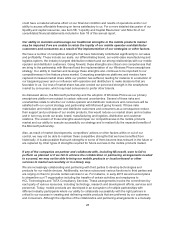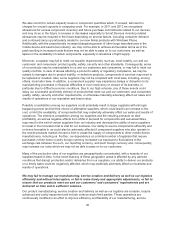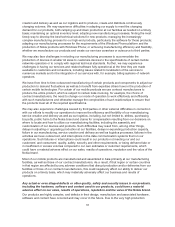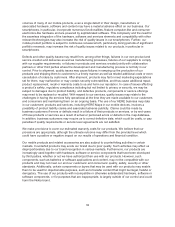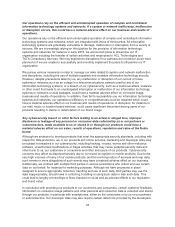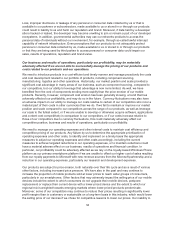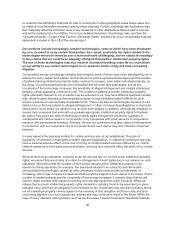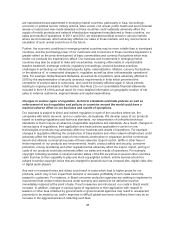Nokia 2012 Annual Report Download - page 39
Download and view the complete annual report
Please find page 39 of the 2012 Nokia annual report below. You can navigate through the pages in the report by either clicking on the pages listed below, or by using the keyword search tool below to find specific information within the annual report.are manufactured and assembled in emerging market countries, particularly in Asia. Accordingly,
economic or political turmoil, military actions, labor unrest, civil unrest, public health and environmental
issues or natural and man-made disasters in those countries could materially adversely affect the
supply of mobile products and network infrastructure equipment manufactured in those countries, our
sales and results of operations. In 2011 and 2012, we witnessed political unrest in various markets
where we do business, which adversely affected our sales in those markets, and any reoccurrence or
escalation of such unrest could do so in the future.
Further, the economic conditions in emerging market countries may be more volatile than in developed
countries, and the purchasing power of our customers and consumers in those countries depends to a
greater extent on the price development of basic commodities and currency fluctuations which may
render our products too expensive to afford. Our business and investments in emerging market
countries may also be subject to risks and uncertainties, including unfavorable or unpredictable
taxation treatment, exchange controls, regulatory proceedings, unsound business practices,
challenges in protecting our intellectual property rights, nationalization, inflation, currency fluctuations,
or the absence of, or unexpected changes in, regulation as well as other unforeseeable operational
risks. For example, Nokia Siemens Networks, as well as its competitors, were adversely affected in
2010 by the implementation of security clearance requirements in India which prevented the
completion of product sales to customers, and could be similarly affected again in future periods,
leading to ongoing uncertainty in that market. See Note 2 to our consolidated financial statements
included in Item 18 of this annual report for more detailed information on geographic location of net
sales to external customers, segment assets and capital expenditures.
Changes in various types of regulation, technical standards and trade policies as well as
enforcement of such regulation and policies in countries around the world could have a
material adverse effect on our business and results of operations.
Our business is subject to direct and indirect regulation in each of the countries where we, the
companies with which we work, and our customers, do business. We develop many of our products
based on existing regulations and technical standards, our interpretation of unfinished technical
standards or there may be an absence of applicable regulations and standards. As a result, changes in
various types of regulations, their application and trade policies applicable to current or new
technologies or products may adversely affect our business and results of operations. For example,
changes in regulation affecting the construction of base stations and other network infrastructure could
adversely affect the timing and costs of new network construction or expansion and the commercial
launch and ultimate commercial success of those networks. Export control, tariffs or other fees or
levies imposed on our products and environmental, health, product safety and security, consumer
protection, money laundering and other regulations that adversely affect the export, import, pricing or
costs of our products could also adversely affect our sales and results of operations. For example,
copyright collecting societies in several member states of the EU as well as in several other countries
claim that due to their capability to play and store copyrighted content, mobile devices should be
subject to similar copyright levies that are charged for products such as compact disc, digital video disc
or digital audio players.
Any new or increased levies and duties could result in costs which lead to higher prices for our
products, which may in turn impair their demand or decrease profitability if such costs cannot be
passed to customers. For instance, in Brazil consumer protection agencies are seeking to implement a
requirement that certain mobile devices under warranty and claimed to be defective must be
immediately replaced at the point of sale. If such measures are introduced, our costs in Brazil would
increase. In addition, changes in various types of regulations or their application with respect to
taxation or other fees collected by governments or governmental agencies may result in unexpected
payments to be made by us, and in response to difficult global economic conditions there may be an
increase in the aggressiveness of collecting such fees.
38


